bolivia, from scratch
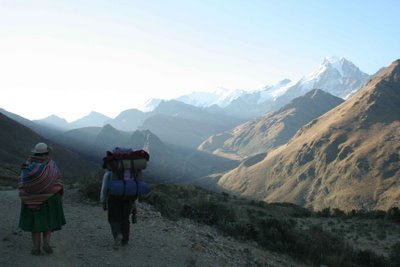
The sun shot its last light between a few craggy peaks in the Apolobamba mountain range in northern Bolivia. Guzman and I were still miles from camp when Seferina was ready for a rest. She had been walking in front of us and now had a chance to study the gringo for a moment. 'So, how many eggs do you have in there anyway?' she asked, pointing at my folded sleeping pad.
......................................................
Three weeks ago Marko and I awoke shivering and heads throbbing at the checkpoint on the Chile-Bolivia border. On the Chilean side a lady bundled against the chill was selling steaming cups of mate de coca (tea infused with coca leaves) to people arriving from lower altitudes. With a full thermos of the age-old remedy for altitude sickness and still another hour before the border opened, we gravitated to a group huddled around a dying fire grilling llama for breakfast. Marinated overnight in garlic, it was chewy, earthy and pungent - a world apart from the completo (hot dog with avocado and mayo) we had eaten the night before in the city of Iquique on the coast.
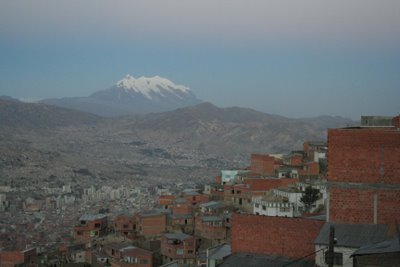
We arrived in La Paz (13,000 feet) in the late afternoon and headed for the central market. Produce from all over Bolivia - from the high altiplano to the low lying jungle - is trucked into the capital and set out in overflowing displays over 30 square blocks. Freeze-dried
 potatoes (frozen in glacial streams for two weeks and then dried on rooftops) are sold along side papaya and passion fruit. Except CocaCola everything is sold in its raw unprocessed form - including the namesake ingredient in Coke's original 'original secret recipe.'
potatoes (frozen in glacial streams for two weeks and then dried on rooftops) are sold along side papaya and passion fruit. Except CocaCola everything is sold in its raw unprocessed form - including the namesake ingredient in Coke's original 'original secret recipe.'We ate every meal at the market. After a week Marko and I had become caseros, something between regular customers and amigos at our favorite vendors. Caseros get a good price and some friendly conversation. At the health tonic pushcart, Antonio asks about my ailments of the day and prepares the appropriate bittersweet herbal mix. He seems to make the same concoction every time, but it still cures everything from a 'loose stomach' to a hangover. For breakfast we went to Marko's main casera, Doña Juana, whose juice stand is always well stocked with carrots, fresh fruit, raw eggs and beer. The
 latter two are blended with sugar to make batido, the local energy drink. (It works, and I would probably drink it more often if it didn't make my burps taste like mayonnaise). Afternoons a block away two ladies sell tukumanas (fried turnovers filled with delicately spiced potatoes and meat) and grilled skewers of thinly sliced beef heart. The big bowl of peanut sauce at their stands keeps me coming back.
latter two are blended with sugar to make batido, the local energy drink. (It works, and I would probably drink it more often if it didn't make my burps taste like mayonnaise). Afternoons a block away two ladies sell tukumanas (fried turnovers filled with delicately spiced potatoes and meat) and grilled skewers of thinly sliced beef heart. The big bowl of peanut sauce at their stands keeps me coming back.Doña Vicky, my lunchtime casera, shares a roof with six small kitchens. While the other cooks are serving two or three people, her four benches are always full. Day laborers lunch alongside business suits - maybe divorced looking for a taste of good home-style cooking. Sit down and immediately a big bowl of soup appears with a small bone with a bit of meat to chew on. Next a choice of two main courses – always a variation of meat and potatoes which changes every day. The food is simple and the portions huge. I can't figure out how she stays open charging 6 Bolivianos (US $.65) for lunch, but after twenty years in the same spot, she's as close as you get to being a star chef at the La Paz central market. I'm waiting for her incredible albondigas ahoghadas (drowning meatballs) to make it back to the rotation before I leave the city.

Marko and I spent nearly two weeks exploring the city and hiking in the nearby mountains. When he left on the morning bus back to Chile, the walk back to the hostel seemed long and I was wondering what to do next. Someone told me about the Apolobamba mountain range. I found a 60 mile trail that connects two towns near the Peru-Bolivia border and hired Guzman, my guide for the five day trek.
.......................................................................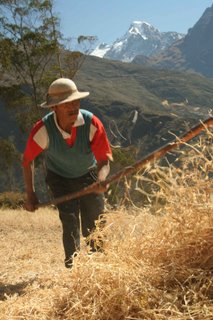 After a bumpy twelve hour bus ride from La Paz, Guzman and I started out on the “trail,” which is the foot path for everyone living and working in the mountains between Charzani and Pelechuco. At lower altitudes the trail winds through terraced hillsides that have been farmed the same way for generations. The harvest was a month ago and the wheat and peas were dry enough for threshing. Higher in the mountains where only stubby grass grows, you pass the solitary outposts of Alpaca shepherds. Still higher you wake up to the rumble of dynamite and the ping of pick axes – sounds of gold mining.
After a bumpy twelve hour bus ride from La Paz, Guzman and I started out on the “trail,” which is the foot path for everyone living and working in the mountains between Charzani and Pelechuco. At lower altitudes the trail winds through terraced hillsides that have been farmed the same way for generations. The harvest was a month ago and the wheat and peas were dry enough for threshing. Higher in the mountains where only stubby grass grows, you pass the solitary outposts of Alpaca shepherds. Still higher you wake up to the rumble of dynamite and the ping of pick axes – sounds of gold mining.
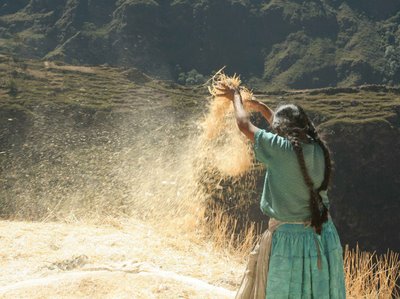
Late on the second day out we were walking with Seferina who was returning to her pueblo. She offered to let us camp in the potato fields in front of her stone-and-thatch home. She was a little disappointed I wasn't carrying any eggs but accepted our invitation to join us for cheese and crackers before bed.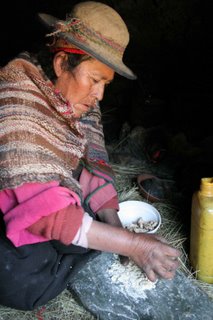
The next morning her older sister Francisca was preparing soup over a small fire when we stopped to say goodbye. As I ducked into the low kitchen, she said something in Quechua – one of two indigenous spoken languages in Bolivia. She spoke no Spanish so we sat in silence as she finished the soup. Wheat, onions, and dried lamb meat had already been simmering for half an hour. She pulverized dried potatoes into flour, peeled and chopped three different kinds of fresh potatoes and emptied everything into the simmering broth.
I pulled out my pocket sized Quechua grammar book gotten in trade for my guide book (which had no mention about Apolobamba). Hoping to find something to start a conversation - or at least make her feel more comfortable with the gringo in her small kitchen, I randomly opened it to 'can I help you with something?' What luck! I pronounced it so poorly I could hear her sister laughing outside. Before I could find something else in Quechua to butcher - I had in mind “can I peel potatoes,” Francisca turned and pointed to her head. Duele mi cabeza. Duele. Duele. From my first aid kit I fished out two Advil for her headache. Everyone knows gringos always carry pills.

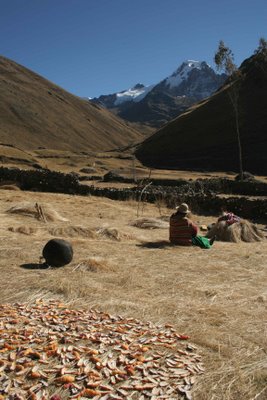 After Francisca finished the soup with salt and herbs, we all ate outside on piles of straw amidst drying potatoes. It was delicious. The broth was meaty and rich, and the wheat and potatoes made it feel satisfying. Every other bite there was a little burst of coriander. She had never heard of coriander, and she produced a dried green herb that looked a lot like oregano. As the Spanish missionaries worked their way through South America and Mexico, they named every pungent green herb 'oregano.' (Substitute Mexican oregano for Italian oregano and you end up with a marinara sauce that tastes more like Pozole.) Apolobamba oregano tastes unmistakably like coriander.
After Francisca finished the soup with salt and herbs, we all ate outside on piles of straw amidst drying potatoes. It was delicious. The broth was meaty and rich, and the wheat and potatoes made it feel satisfying. Every other bite there was a little burst of coriander. She had never heard of coriander, and she produced a dried green herb that looked a lot like oregano. As the Spanish missionaries worked their way through South America and Mexico, they named every pungent green herb 'oregano.' (Substitute Mexican oregano for Italian oregano and you end up with a marinara sauce that tastes more like Pozole.) Apolobamba oregano tastes unmistakably like coriander.Suddenly Francisca broke into tears. As Leonora explained to us in Spanish, her sister has been having headaches for two years now as her eyesight has gotten worse and worse. Six months ago she stopped weaving. I offered eye drops and she accepted without hesitation. Remembering Mom's treatment for surfers’ eyes, I cradled her head and with some difficulty put a few drops into each eye. Then I doused my handkerchief with water, folded it over her eyes and lightly rubbed her forehead. I was tentative at first, but it was clear that it was welcome.

Doña Vicky's Albondigas Ahoghadas
For the meatballs combine the following in an appropriate sized bowl:
2 pounds ground beef
3 eggs
1 tsp. ground cumin
1 tsp. ground pepper
1 Tbsp. parsley, finely chopped
1 onion, diced
1 tomato, grated on a cheese grater
1 cup bread crumbs
2 Tbsp salt
Ahoghada sauce:
1 Tbsp. dried ground chile california
3 onions, diced
1 tomato, diced
1 cup green peas
1 cup water
salt to taste
1. Before going to the trouble of shaping all the meatballs, preheat a pan, add a tablespoon or two of oil, and cook a tester. Add seasoning as you see fit.
2. Shape the meatballs into the size of golf balls. Cook them in batches of five or six. Take your time and don't crowd the pan - you want to keep the pan hot so the meatballs get nice and brown.
3. While the meatballs are cooking preheat another pan and add two tablespoons oil. Add the onions, chile powder and tomato and saute over low heat. When the onions are soft and transluscent, add the peas and water. Simmer for a few minutes and add salt to taste.
4. Transfer browned meatballs to the pan with the sauce. Simmer everything for a minute and serve with rice and boiled potatoes. Top with chopped parsley.
Sopita Apolobambina
To capture the spirit of Bolivian soups, boil whatever you have on hand until tender and season according to personal taste. Potatoes - dried and fresh - are always present. Wheat, corn, quinoa, and sometimes even semolina flour are used interchageably to fortify soups. City cooks make the broth with beef bones whereas country cooks use lamb. The latter has a much more assertive flavor.
3-4 lbs. beef bones or lamb shanks
3 lbs potatoes (use multiple varieties if possible), cut into half inch chunks
1 onion, diced
1 carrot, diced
1 cup wheat berries
1 tsp coriander seed
salt to taste
1. Put the bones in a large pot and cover with water. Bring to a boil and skim off the white foam that collects at the surface. Simmer for forty minutes.
2. Add the wheat, onion and carrot and simmer for another fifteen minutes.
3. Add the potatoes and simmer unitl tender. Add salt to taste.
4. This step is optional but will yield a more substantial broth: transfer four cups of broth and half the potato chunks to a blender and blend till smooth. Return puree to broth and stir well.
4. Heat a pan over medium heat and add the coriander seed. When you hear them start to pop, remove the pan from the heat. Add seeds to soup and let it sit for a few minutes before serving. The meat should be fall apart tender.



14 Comments:
Que montañas. Y las albondigas hmmm. Te estoy esperando para ir a PALOQUEMAO Bogota's freshness paradise
fede
beautiful pictures! really amazing! u are funny, travelling around with pills that to the local people seem like the cure it all drug! lots of love claudia
Que envidia me das... menudo viaje de ensueño. Ten miedo del cabrón de fede porque tiene unas ganas de verte... QUE SIGAS PASÁNDOLO TAN BIEN, UN SALUDO DESDE LA PENÍNSULA IBÉRICA...
JDF
I am traveling through your eyes and indigenous pallet...
Thank you
Mary
Se ve que te la estas pasando muy bien, me da mucho gusto por ti. Cuando quieras eres bienvenido de nuevo a México.
Un abrazo
Omar
Great pictures!
Thank you for the voyage...
:)
Very good photos my friend. I have yet to cook one of your recipes, but I will venture to make one soon. Siga disfrustando todo que ves.
- Aaron
p.s. My roommate made the "frites", but she did it veggie-style and they were mushy. I will get beef fat the next time and do it myself.
Mi querido amigo Eric:
Te extraño mucho. Lei tus recetas y ten por seguro que las pondre en practica en nuestro nuevo Menu en el Oldenborg Dining Hall. Creo que me quedaré ahi un año mas. Que lindos lugares has visitado! sigue disfrutandolos! y que bueno que incluyes recetas pues asi tengo la oportunidad de incluir autenticas comidas en el Menu.
Te mando muchos abrazos,
Con cariño,
Martha Eugenia
you are at it again. looks amazing, and makes me jealous. we miss you in the bay, but realize that you are on to bigger and better things. dont stop.
og pigeon
i don't know how to read and so only looked at the pictures - i hear they're worth more anyway.
miss you and your bread.
my life is crazier and more fun than ever.
love ya!
- isaac
Eric - the cobblestone streets and sopa de chipilin are still waiting for you in Chiapas - sure your pictures look great and everything and your words bring a tear to the eye, but I miss you and your cooking!! Un abrazo muy fuerte, tu hermanita chiapaneca, Laurel
I think I am sexually attracted to the mountains in your first photograph.
Sonam
may your continous-collective journey for ingredients (etheral,visual,virtual,and tasty) lead you to your own OpenKitchen....
-Ale.
Hi Eric - thanks again for sharing such gorgeous pictures and your story - everything fascinates me and every time I visit your site, I feel even stronger that I must visit there... Looking forward to reading more.
Post a Comment
<< Home